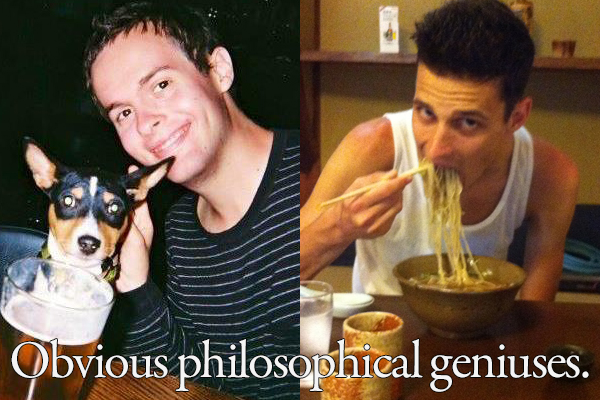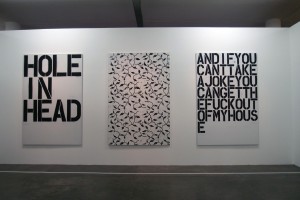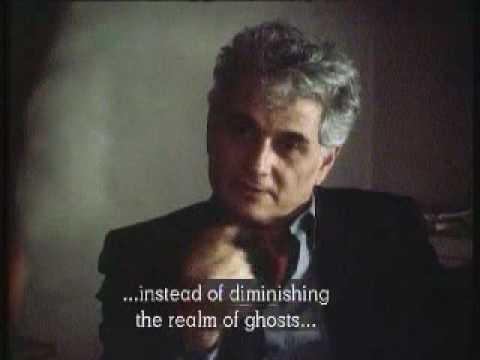Felix Bernstein’s Response to Vanessa Place, Slavoj Žižek, Trisha Low, and more
Beyond Vampires and Zombies
An Essay by Felix Bernstein
Vanessa Place’s latest manifesto “Zombie Poetry”[1] accurately frames her modus operandi: to glorify (and sanitize) Freud’s death drive (in which, doomed to never get what you want, satisfactory pleasure becomes impossible), over and against eros (the principle of maximizing pleasure). She provides a didactic demonstration of the death drive by casting herself in the role of Thanatos, a self-proclaimed undead zombie, feeding off (appropriating) the naïve pleasure of those feebleminded creatures who attempt to maximize pleasure, lecturing us that our notion of satisfaction and of mastery is a lie. Place is largely influenced by the famous schtick of Lacanian philosopher Slavoj Zizek, who is a master of belittling the part of us that believes we will find fulfilling objects. His refrain, like the song, is you can’t get what you want but you can get what you need, with this kicker: what you need is an unpleasant excess in the object of your desire that serves as a reminder/remainder of that which is denied in sexual relationships. This unpleasant excess, so-named “the kernel of the real,” can be found as the remainder of fantasies and mathematical equations To extract this rem(a)inder, you must read between the lines of speech, strictly under the Lacanian rubric. Then you will always find this same truth: the split subject, barred from accessing its full desire; in other words, the truth is the failure of desire. And this truth will always be delivered, for it is universally applicable.
For Place, those ‘poets’ who have not taken the conceptual turn that she prescribes, are in the thrall of a silly fantasy that our words might matter before they are decoded, analyzed, or appropriated by a master-analyst. [2]. This is her charge against those poets who have not sufficiently removed themselves from the craft of voicing desire. But also, more troubling, the voices that Place appropriates (the dumb college jokes, the early feminist dogmas, the victim’s testimony) all are framed as being (in their original utterances) naively unaware of the critical discourse into which she is happy to drag them. Those who take on the ‘voices of others,’ be they infused by the traditions of Language or Flarf or New York School poetics [or romanticism or camp or punk] will for Place indulge in an ideological fantasy that does not properly recognize or critique itself. But we all indulge a bit now and then, don’t we? And so it is only human (in the ‘living breathing’ sense) that now, in “Zombie Poetry” when the prospect of Place herself losing relevance enters the scene, that she can finally ask us to be concerned about the personal, the tragic, and the autobiographical, at the expense of the comic and universal. Now, she begs, we ought to look at her particular case, her particular deadpan style, her “I’m melting” bathos, and feel for her! That is, we ought to feel for the woman who is unfeeling.
Indeed, those who do feel for Place now, those who do still recognize her as a mother to their art, but refuse to follow her dogmatically, even those followers, she ridicules for being stupid enough to ‘pay her’ to fulfill this role. By her own calculations, it is inconsequential whether or not one ‘likes’ Vanessa Place, for ‘liking’ is merely a dumb, naïve, response, suitable for social media. It only matters whether or not one is driven to her. And she will, indeed, find that many will be driven her way. And driven by a death drive that is, unlike the one late Freud describes, vaguely pleasant. That is because it is nothing other than a performance of death drive, in the skilled manner of Place or Zizek, it is intelligible, hip, ironic, and stripped of any great dangers. It is in fact more optimistic, gung-ho, communal, and ego-affirming than those arts that indulge openly in true eros. It does not threaten civilization or even make us better understand its discontents. Rather, such performance of thanatos smoothly valorizes what might otherwise have been disruptive, if it were rendered with aesthetic brilliance instead of uncompromising didactic un-deadness.
The vampiric persona has long been iconic of positive, sympathetic, communal identification with the death drive. This identification goes beyond “Garbo is the best” because it is also ” “Garbo’s coldness is our coldness.” Even when nakedly announced in Freudian terms, the death drive is often used as communally binding tool; for example, Lee Edelman’s No Future: Queer Theory and the Death Drive, a revered book in the literary academy (not to mention in the cults around Freud, Zizek, and Lacan). The art world and the pop world, epitomized by Warhol or Lady Gaga, respectively, has found numerous ways to cash in on such glamorous thanatos; but too often the result is art that has zero stakes in its self-conscious display of determinately empty signifiers. Such vampiric signifying feeds on the flesh of signifiers, styles, and dialects that remains alive for those “others” from whom they are appropriated. The vampire thrives via the necrotizing of living symbols for the purpose of galvanizing cash and social mobility. This is why Claire Bishop can praise ‘dark, critical, negativity’ in art (and find Conceptual Poetry to be perfectly negative), all the while, attempting unabashedly to usher these ‘negative’ new forms of art in to the halls of high commodities, with her critical stamp of approval writ large. Of course, such ‘negativity,’ as Zizek or Place or Gaga or Warhol offers, is only as ‘negative’ as it is completely intelligible to art audiences, and it will be forever intelligible because it has no ambivalence about using the signifier, ruthlessly, to prove its point (which is, after all, nothing more than to show that the empty signifier trumps what is conservatively viewed to be an authentic display of desire). But maybe the simplest example to look to, for now, is Twilight, where young Bella, ambivalent about how to register affect, ends up choosing the learned, urbane, death drive of the vampires over and against the dumb, rural, pleasure principle of the werewolves. Which one would you pick? It must be hard being a young post-feminist!
THE PERENNIAL AMBIGUITY OF CHRISTOPHER WOOL
I like Christopher Wool’s artwork. Wool became famous for his paintings of strong, provocative phrases in black letters, primarily ALL CAPS. Wool’s works are of an abstract nature, sometimes intricate in presenting an idea, other times arcanely elusive. In October’s Vogue Dodie Kazanjian scored a rare interview with the media-reclusive artist. The format and presentation of the arguments the writer provides to the text more closely resembles that of an essay, but many intriguing themes come up.
By introducing Willem de Kooning’s approach to artistic work–who worked “out of doubt”–as a starting point, the writer reveals the artistic intentions of Wool to be consistent in their omnipresent questioning and doubting. They are works defined by what Kazanjian calls a “perennial ambiguity.” This ambiguity may also be viewed as the proclamation of the honest confusion of an artist. Thus, the refusal of adopting an authoritative style should not be considered the result of limited intellectual rigor, but rather should be respected for its humility.
Discussing his artistic aspirations and how he managed to become a significant part of the modern art world, Wool asserts that his path was somewhat coincidental. “It just kind of happened,” he states. A key to his success was possibly that his early years in New York coincided with a legendary era of NY nightlife and culture: CBGB and Max’s Kansas City. The intersection of nightlife and the art-reality that was being created was evident in the 1980s, and shaped the public’s perception of artists’ role.
Upon revisiting his old work, the artist himself confesses: “They were offensive, funny, and indelible–you had to pay attention.” Consequently, it is not surprising that the critical response to his work varied. Some thought it populist in its negativity, while others observed in it a radical stance: a cacophonous harmony, or a refreshing pathos. What is predictable in his work is Wool’s lack of “conclusiveness” or the absence of artistic closure.
“I firmly believe it’s not the medium that’s important, it’s what you do with it,” the artist clarifies.
Of critical theory
Forty years ago Harold Rosenberg said “art in our time cannot escape having a political content and moral implications. Criticism that is unaware of this is fatally poverty-stricken.” Today you can look for critical theory behind cans of soup at the supermarket. You can find it in your apartment, or in your home. Maybe your pool, if you have a pool. Your cat can teach you critical theory. Your dog is chasing a squirrel. There’s a lesson here somewhere, everywhere. Even at the corner store. Not in the trees. The trees can’t tell you about critical theory, but the wind can. You don’t need a sense of humor to know it’s raining a lot. Look around. Better yet, look at yourself. Harder. Look harder and deeper at yourself. And see that you are just an it. Critical theory is the space between things. There are books entirely on this lack of space. More books all the time more books on theory. Eat. But you don’t need to read the books. You just need to pay attention to them. Let them envelop the you that you thought you were in rust. Give yourself to them, and you will find that you weren’t really. But they are and they aren’t. And it’s never enough to think that you know, because you don’t. All there is is an idea of something between the things, spreading them out, making them whole. A ghost. Find it in the penny fountain at the mall below the sun light crashing gently thru the atrium, so high above. It’s in the dust on the plants next to the food court, where the last sandwich artist makes too-hot coffee for the grandmas and the grandpas, stretching out their limbs like wet shirts hung over a dry line strung between two buildings within several larger buildings, waiting to learn what it’s like to be an idea in the mind of someone living without knowing they’re going to die.
THIS IS THE EK-STATIC CITY: THOUGHTS ON KIM HYESOON’S POETRYAND POETICS
***
In “Poetry of Hearing,” Kim Hyesoon has this to say regarding the spirit: “Does it stay “outside” and take over someone (a woman in particular) ….. Or is the spirit something that gushes out from someone’s insides— someone who is ill and in severe pain, ….. like a virus, like love, or something that is called a ghost because it is nameless?” (Princess Abandoned)
Hyesoon’s poetry and poetics have mainly been discussed in terms of the grotesque, but they also hover around questions regarding the experience and performance of spirit. I see the ek-static as the experience of spirit, and ek-stasis to be its performance. Ekstasis seems to be a necessary bridge between Kim Hyesoon’s atavistic discussion of spirit in her poetics and the violence it informs, experiences, and envisions in her poetry, in that the symbolic and its identification with the grotesque is also the ekstatic or, in Norman O. Brown’s sense, the telepathic, a merging of bodies, or, the spirit’s experience.
READ MORE >
September 18th, 2013 / 11:24 am
We Got Sick of Theory and Talked About That

Between July 9th and August 5th , Alec Niedenthal and I had a long & blabby conversation that began when Alec enthusiastically responded to me saying “I’m almost completely gagged now by fucks like Deleuze.” Knowing Alec mostly as a fellow young philosophy & theory head, I asked after his newfound disillusionment with the stuff.
That conversation posted here—mostly unedited—in hopes you find it useful or rousing.
Ken: What literature strikes you as bullshit now?
Alec: Your question is great, but I’m not sure that I’m equipped to answer it. I’ll explain why. First, I’m not sure how possible it is today to talk about what sort of art is valueless, ie bullshit, when the role of art is so unclear and, less evidently but no less significantly, when we as avant-garde writers are unsure whether there should be an institution called “Art” any longer. That’s to say, it’s hard to even talk about what literature should be doing when the “should”-level claim about literature in general—basically, what it ought to depict and how to depict it—is supposed to be. READ MORE >
Vote for your favorite experience

I guess this post is about the illusion of choice, and the anxiety of it.
The two big news stories of the day, aren’t really stories, and don’t really matter, unless you’re some kind of power player in NYC politics, or someone trying to make a living by manufacturing iPhones in an industrial park in China.
Publishing Genius 2.0 Kickstarter: 28 Hours Left!
 George Washington once said, “There is nothing which can better deserve your patronage, than the promotion of science and literature.” Over at the Publishing Genius 2.0 Kickstarter, you can patronize both science AND literature by helping Adam Robinson publish 5 works of literature in 2014. That man has publishing down to a science! Once you contribute, you can enter for a chance for me to double your reward by commenting here. Or right here is fine, too; I’ll check both. Do it for science! Do it because George Washington said so during history! Speaking of history, here’s one of Publishing Genius Press itself. And if you like that dose of amiable reality about the mighty effort and unsurpassed talent it takes to build an independent press empire, you’ll be thrilled to hear that any Kickstarter donation of $25 or more gets you Adam’s e-book, Our Primary Focus, a history-in-interviews of innovations in the book business. SO hurry hurry and dig out as many pocket Washingtons as you can find and patronize PGP!
George Washington once said, “There is nothing which can better deserve your patronage, than the promotion of science and literature.” Over at the Publishing Genius 2.0 Kickstarter, you can patronize both science AND literature by helping Adam Robinson publish 5 works of literature in 2014. That man has publishing down to a science! Once you contribute, you can enter for a chance for me to double your reward by commenting here. Or right here is fine, too; I’ll check both. Do it for science! Do it because George Washington said so during history! Speaking of history, here’s one of Publishing Genius Press itself. And if you like that dose of amiable reality about the mighty effort and unsurpassed talent it takes to build an independent press empire, you’ll be thrilled to hear that any Kickstarter donation of $25 or more gets you Adam’s e-book, Our Primary Focus, a history-in-interviews of innovations in the book business. SO hurry hurry and dig out as many pocket Washingtons as you can find and patronize PGP!
Exercise Routines of Skinny White Male Writers
I graduated 200th in my class out of 400 students. This talent for ridding the middle also translated to sports. During gym, when Coach Monty split the class into the jocks and the fats, I was first lumped into the fats because I was tall and lanky, a weird looking kid who appeared a bit too pretty and totally indifferent to the movement of a ball. But I would dominate the fats so I’d be placed with the jocks, and thusly be dominated by the jocks, and then sent back to the fats where I glided in for uncontested layup after layup. Once, I got rim, and someone referred to me as “speed demon.”







